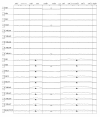Genomic diversity of citrate fermentation in Klebsiella pneumoniae
- PMID: 19682387
- PMCID: PMC2735749
- DOI: 10.1186/1471-2180-9-168
Genomic diversity of citrate fermentation in Klebsiella pneumoniae
Abstract
Background: It has long been recognized that Klebsiella pneumoniae can grow anaerobically on citrate. Genes responsible for citrate fermentation of K. pneumoniae were known to be located in a 13-kb gene cluster on the chromosome. By whole genome comparison of the available K. pneumoniae sequences (MGH 78578, 342, and NTUH-K2044), however, we discovered that the fermentation gene cluster was present in MGH 78578 and 342, but absent in NTUH-K2044. In the present study, the previously unknown genome diversity of citrate fermentation among K. pneumoniae clinical isolates was investigated.
Results: Using a genomic microarray containing probe sequences from multiple K. pneumoniae strains, we investigated genetic diversity among K. pneumoniae clinical isolates and found that a genomic region containing the citrate fermentation genes was not universally present in all strains. We confirmed by PCR analysis that the gene cluster was detectable in about half of the strains tested. To demonstrate the metabolic function of the genomic region, anaerobic growth of K. pneumoniae in artificial urine medium (AUM) was examined for ten strains with different clinical histories and genomic backgrounds, and the citrate fermentation potential was found correlated with the genomic region. PCR detection of the genomic region yielded high positive rates among a variety of clinical isolates collected from urine, blood, wound infection, and pneumonia. Conserved genetic organizations in the vicinity of the citrate fermentation gene clusters among K. pneumoniae, Salmonella enterica, and Escherichia coli suggest that the 13-kb genomic region were not independently acquired.
Conclusion: Not all, but nearly half of the K. pneumoniae clinical isolates carry the genes responsible for anaerobic growth on citrate. Genomic variation of citrate fermentation genes in K. pneumoniae may contribute to metabolic diversity and adaptation to variable nutrient conditions in different environments.
Figures




Similar articles
-
Genome sequencing and comparative analysis of Klebsiella pneumoniae NTUH-K2044, a strain causing liver abscess and meningitis.J Bacteriol. 2009 Jul;191(14):4492-501. doi: 10.1128/JB.00315-09. Epub 2009 May 15. J Bacteriol. 2009. PMID: 19447910 Free PMC article.
-
Genetic diversity of capsular polysaccharide biosynthesis in Klebsiella pneumoniae clinical isolates.Microbiology (Reading). 2009 Dec;155(Pt 12):4170-4183. doi: 10.1099/mic.0.029017-0. Epub 2009 Sep 10. Microbiology (Reading). 2009. PMID: 19744990
-
Characterization of integrative and conjugative element ICEKp1-associated genomic heterogeneity in a Klebsiella pneumoniae strain isolated from a primary liver abscess.J Bacteriol. 2008 Jan;190(2):515-26. doi: 10.1128/JB.01219-07. Epub 2007 Nov 2. J Bacteriol. 2008. PMID: 17981959 Free PMC article.
-
Regulation of anaerobic citrate metabolism in Klebsiella pneumoniae.Mol Microbiol. 1995 Nov;18(3):533-46. doi: 10.1111/j.1365-2958.1995.mmi_18030533.x. Mol Microbiol. 1995. PMID: 8748036
-
Correlation of Klebsiella pneumoniae comparative genetic analyses with virulence profiles in a murine respiratory disease model.PLoS One. 2014 Sep 9;9(9):e107394. doi: 10.1371/journal.pone.0107394. eCollection 2014. PLoS One. 2014. PMID: 25203254 Free PMC article.
Cited by
-
Bacterial community analysis identifies Klebsiella pneumoniae as a native symbiotic bacterium in the newborn Protobothrops mucrosquamatus.BMC Microbiol. 2023 Aug 8;23(1):213. doi: 10.1186/s12866-023-02936-4. BMC Microbiol. 2023. PMID: 37553640 Free PMC article.
-
Characterization of Klebsiella sp. strain 10982, a colonizer of humans that contains novel antibiotic resistance alleles and exhibits genetic similarities to plant and clinical Klebsiella isolates.Antimicrob Agents Chemother. 2014;58(4):1879-88. doi: 10.1128/AAC.01605-13. Epub 2014 Jan 6. Antimicrob Agents Chemother. 2014. PMID: 24395222 Free PMC article.
-
Mechanisms of Bacterial Tolerance and Persistence in the Gastrointestinal and Respiratory Environments.Clin Microbiol Rev. 2018 Aug 1;31(4):e00023-18. doi: 10.1128/CMR.00023-18. Print 2018 Oct. Clin Microbiol Rev. 2018. PMID: 30068737 Free PMC article. Review.
-
Implications of the expression of Enterococcus faecalis citrate fermentation genes during infection.PLoS One. 2018 Oct 18;13(10):e0205787. doi: 10.1371/journal.pone.0205787. eCollection 2018. PLoS One. 2018. PMID: 30335810 Free PMC article.
-
Haemophilus ducreyi Seeks Alternative Carbon Sources and Adapts to Nutrient Stress and Anaerobiosis during Experimental Infection of Human Volunteers.Infect Immun. 2016 Apr 22;84(5):1514-1525. doi: 10.1128/IAI.00048-16. Print 2016 May. Infect Immun. 2016. PMID: 26930707 Free PMC article.
References
Publication types
MeSH terms
Substances
LinkOut - more resources
Full Text Sources
Molecular Biology Databases

